Excellence Model: Capabilities of an Effective HR Manager Explored
VerifiedAdded on 2023/06/13
|6
|1440
|64
Report
AI Summary
This report delves into the critical capabilities that define an excellent Human Resource (HR) manager, drawing upon the AHRI's 'Model of Excellence.' It emphasizes three key areas: being 'Business Driven,' which involves understanding organizational context and aligning HR strategies with business goals; 'Workforce and Workplace Designer,' focusing on creating a positive and productive work environment to attract and retain talent; and 'Stakeholder Mentor and Coach,' highlighting the importance of building strong, mutually beneficial relationships with internal and external stakeholders through transparent communication and trust-building. The report underscores how these capabilities are essential for driving employee motivation, enhancing productivity, and fostering a strong, engaged workforce, ultimately contributing to the long-term success of the organization.
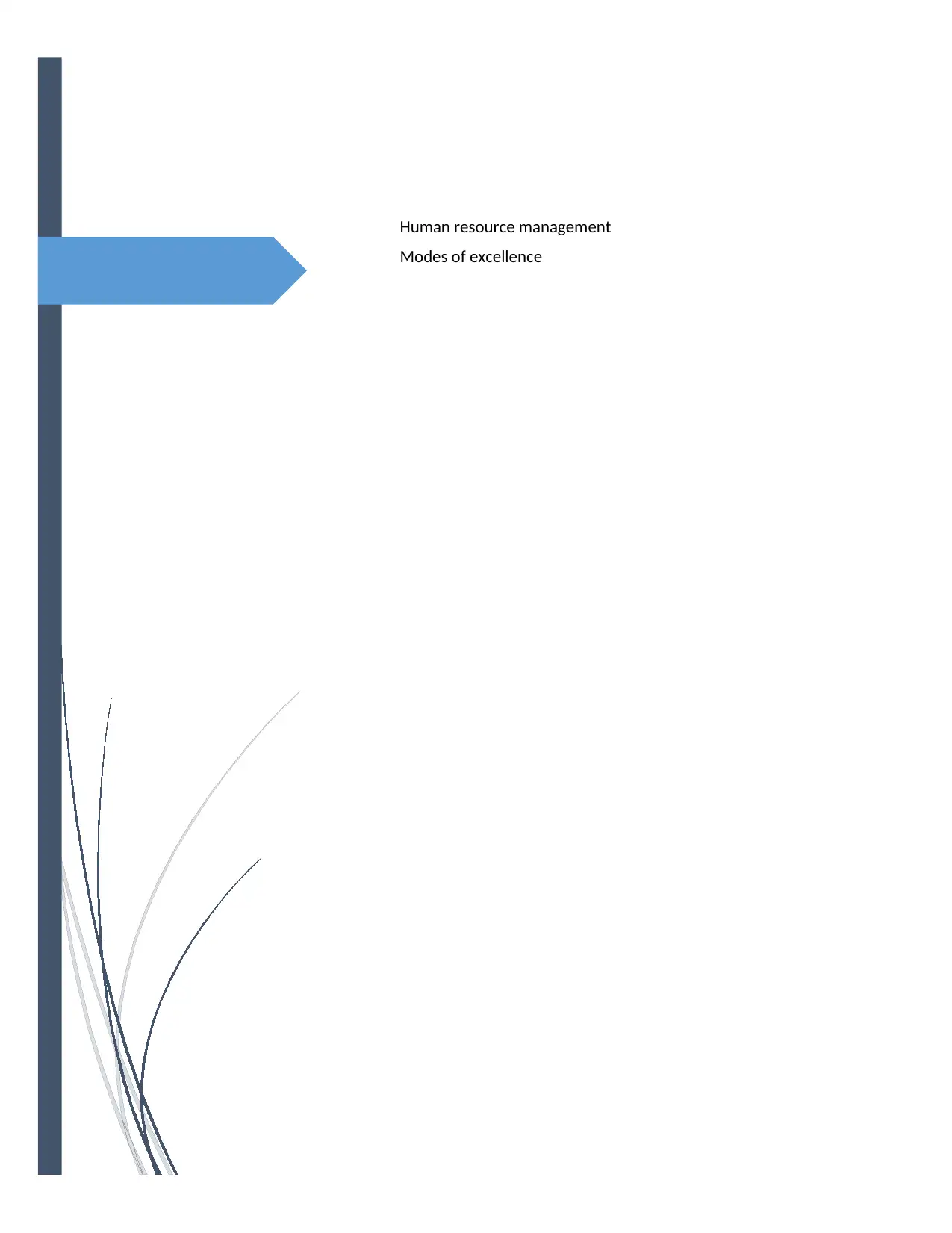
Human resource management
Modes of excellence
Modes of excellence
Paraphrase This Document
Need a fresh take? Get an instant paraphrase of this document with our AI Paraphraser
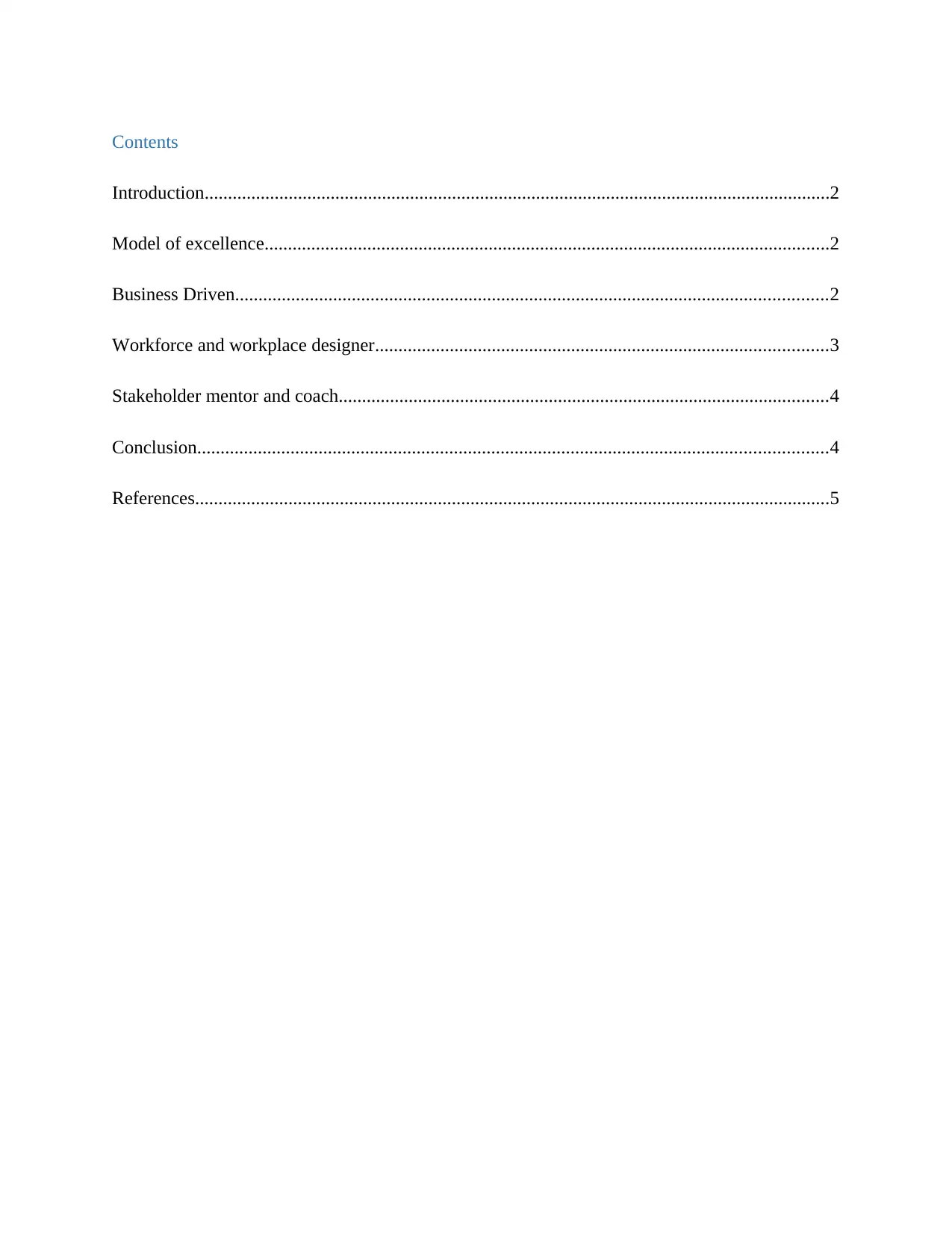
Contents
Introduction......................................................................................................................................2
Model of excellence.........................................................................................................................2
Business Driven...............................................................................................................................2
Workforce and workplace designer.................................................................................................3
Stakeholder mentor and coach.........................................................................................................4
Conclusion.......................................................................................................................................4
References........................................................................................................................................5
Introduction......................................................................................................................................2
Model of excellence.........................................................................................................................2
Business Driven...............................................................................................................................2
Workforce and workplace designer.................................................................................................3
Stakeholder mentor and coach.........................................................................................................4
Conclusion.......................................................................................................................................4
References........................................................................................................................................5
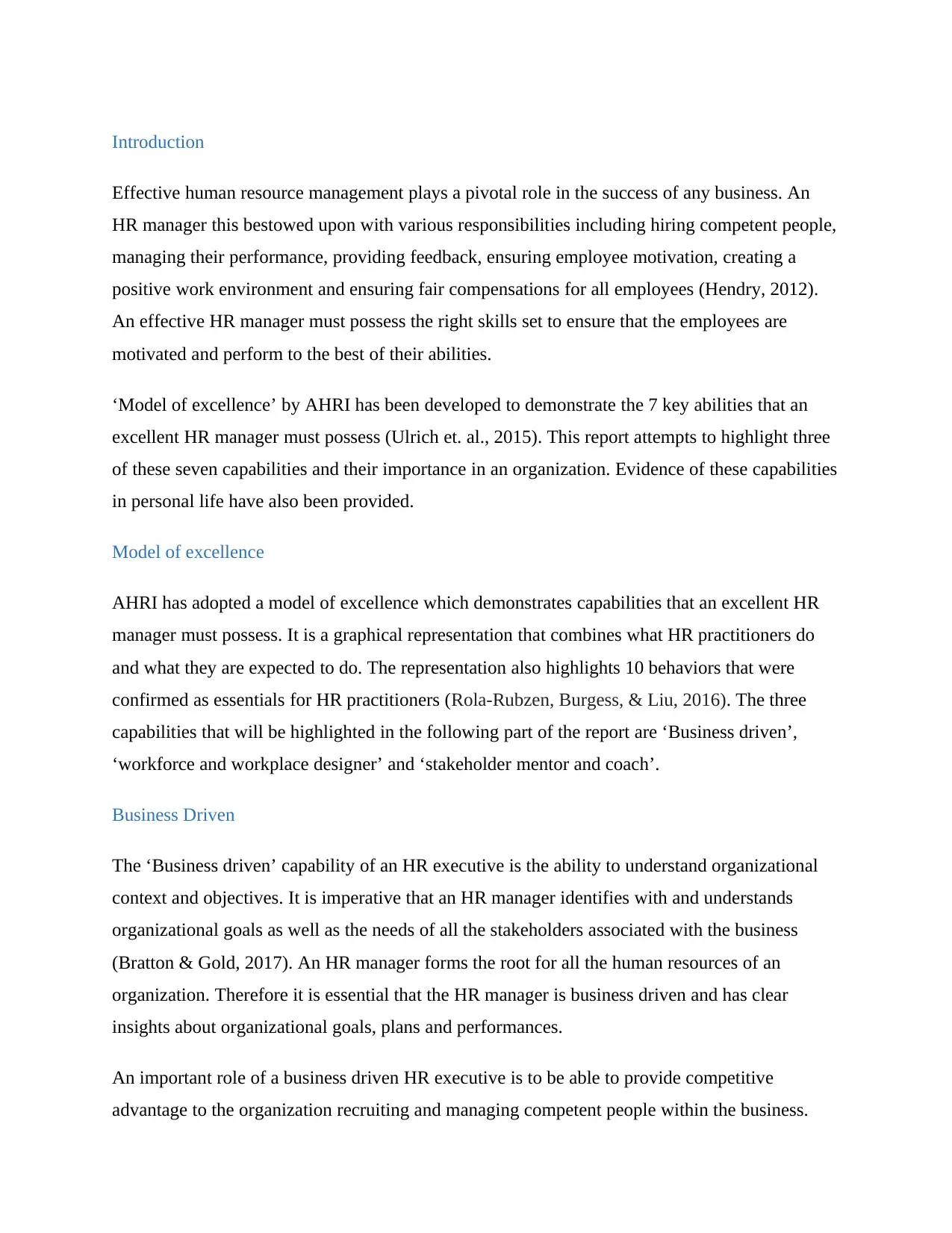
Introduction
Effective human resource management plays a pivotal role in the success of any business. An
HR manager this bestowed upon with various responsibilities including hiring competent people,
managing their performance, providing feedback, ensuring employee motivation, creating a
positive work environment and ensuring fair compensations for all employees (Hendry, 2012).
An effective HR manager must possess the right skills set to ensure that the employees are
motivated and perform to the best of their abilities.
‘Model of excellence’ by AHRI has been developed to demonstrate the 7 key abilities that an
excellent HR manager must possess (Ulrich et. al., 2015). This report attempts to highlight three
of these seven capabilities and their importance in an organization. Evidence of these capabilities
in personal life have also been provided.
Model of excellence
AHRI has adopted a model of excellence which demonstrates capabilities that an excellent HR
manager must possess. It is a graphical representation that combines what HR practitioners do
and what they are expected to do. The representation also highlights 10 behaviors that were
confirmed as essentials for HR practitioners (Rola-Rubzen, Burgess, & Liu, 2016). The three
capabilities that will be highlighted in the following part of the report are ‘Business driven’,
‘workforce and workplace designer’ and ‘stakeholder mentor and coach’.
Business Driven
The ‘Business driven’ capability of an HR executive is the ability to understand organizational
context and objectives. It is imperative that an HR manager identifies with and understands
organizational goals as well as the needs of all the stakeholders associated with the business
(Bratton & Gold, 2017). An HR manager forms the root for all the human resources of an
organization. Therefore it is essential that the HR manager is business driven and has clear
insights about organizational goals, plans and performances.
An important role of a business driven HR executive is to be able to provide competitive
advantage to the organization recruiting and managing competent people within the business.
Effective human resource management plays a pivotal role in the success of any business. An
HR manager this bestowed upon with various responsibilities including hiring competent people,
managing their performance, providing feedback, ensuring employee motivation, creating a
positive work environment and ensuring fair compensations for all employees (Hendry, 2012).
An effective HR manager must possess the right skills set to ensure that the employees are
motivated and perform to the best of their abilities.
‘Model of excellence’ by AHRI has been developed to demonstrate the 7 key abilities that an
excellent HR manager must possess (Ulrich et. al., 2015). This report attempts to highlight three
of these seven capabilities and their importance in an organization. Evidence of these capabilities
in personal life have also been provided.
Model of excellence
AHRI has adopted a model of excellence which demonstrates capabilities that an excellent HR
manager must possess. It is a graphical representation that combines what HR practitioners do
and what they are expected to do. The representation also highlights 10 behaviors that were
confirmed as essentials for HR practitioners (Rola-Rubzen, Burgess, & Liu, 2016). The three
capabilities that will be highlighted in the following part of the report are ‘Business driven’,
‘workforce and workplace designer’ and ‘stakeholder mentor and coach’.
Business Driven
The ‘Business driven’ capability of an HR executive is the ability to understand organizational
context and objectives. It is imperative that an HR manager identifies with and understands
organizational goals as well as the needs of all the stakeholders associated with the business
(Bratton & Gold, 2017). An HR manager forms the root for all the human resources of an
organization. Therefore it is essential that the HR manager is business driven and has clear
insights about organizational goals, plans and performances.
An important role of a business driven HR executive is to be able to provide competitive
advantage to the organization recruiting and managing competent people within the business.
⊘ This is a preview!⊘
Do you want full access?
Subscribe today to unlock all pages.

Trusted by 1+ million students worldwide
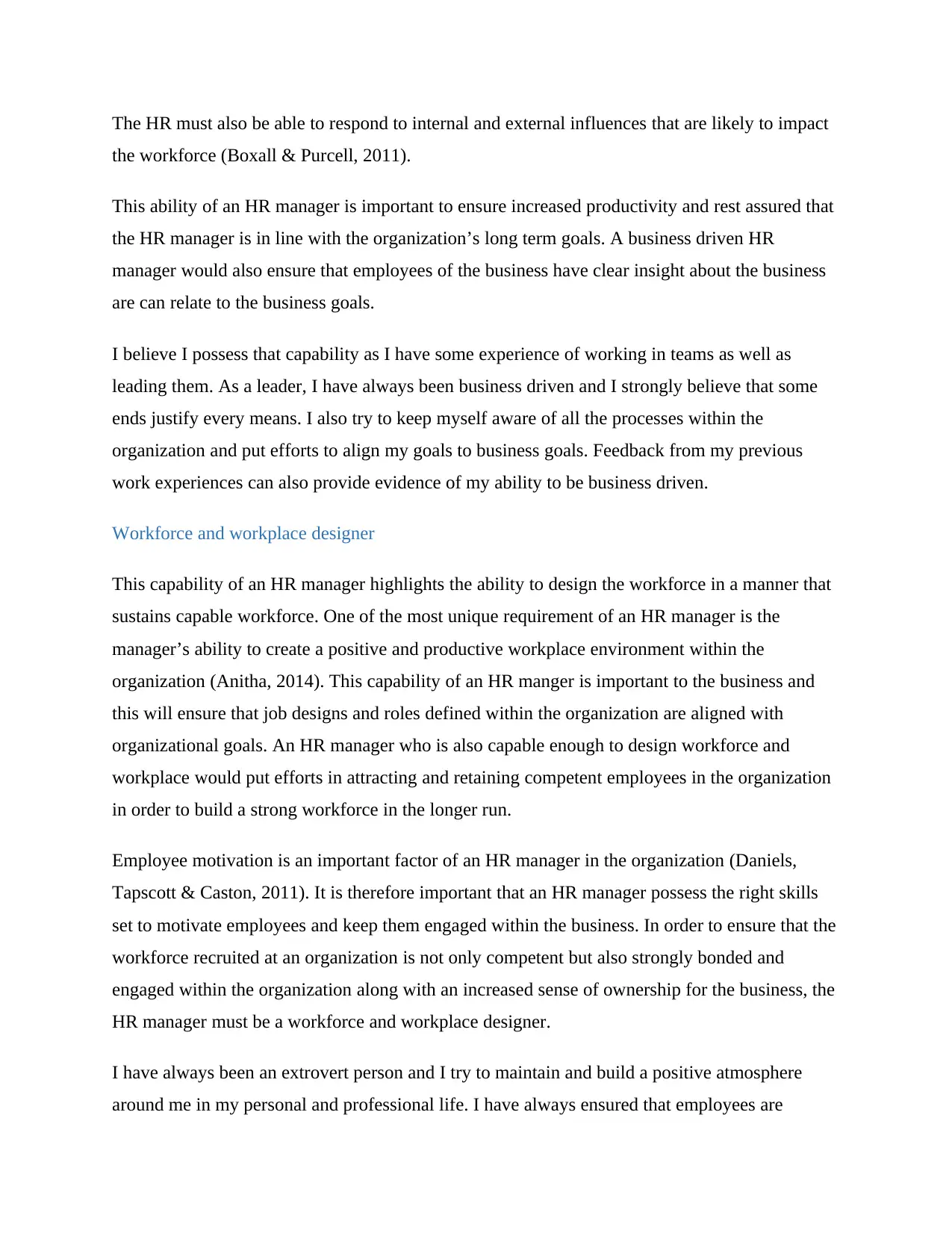
The HR must also be able to respond to internal and external influences that are likely to impact
the workforce (Boxall & Purcell, 2011).
This ability of an HR manager is important to ensure increased productivity and rest assured that
the HR manager is in line with the organization’s long term goals. A business driven HR
manager would also ensure that employees of the business have clear insight about the business
are can relate to the business goals.
I believe I possess that capability as I have some experience of working in teams as well as
leading them. As a leader, I have always been business driven and I strongly believe that some
ends justify every means. I also try to keep myself aware of all the processes within the
organization and put efforts to align my goals to business goals. Feedback from my previous
work experiences can also provide evidence of my ability to be business driven.
Workforce and workplace designer
This capability of an HR manager highlights the ability to design the workforce in a manner that
sustains capable workforce. One of the most unique requirement of an HR manager is the
manager’s ability to create a positive and productive workplace environment within the
organization (Anitha, 2014). This capability of an HR manger is important to the business and
this will ensure that job designs and roles defined within the organization are aligned with
organizational goals. An HR manager who is also capable enough to design workforce and
workplace would put efforts in attracting and retaining competent employees in the organization
in order to build a strong workforce in the longer run.
Employee motivation is an important factor of an HR manager in the organization (Daniels,
Tapscott & Caston, 2011). It is therefore important that an HR manager possess the right skills
set to motivate employees and keep them engaged within the business. In order to ensure that the
workforce recruited at an organization is not only competent but also strongly bonded and
engaged within the organization along with an increased sense of ownership for the business, the
HR manager must be a workforce and workplace designer.
I have always been an extrovert person and I try to maintain and build a positive atmosphere
around me in my personal and professional life. I have always ensured that employees are
the workforce (Boxall & Purcell, 2011).
This ability of an HR manager is important to ensure increased productivity and rest assured that
the HR manager is in line with the organization’s long term goals. A business driven HR
manager would also ensure that employees of the business have clear insight about the business
are can relate to the business goals.
I believe I possess that capability as I have some experience of working in teams as well as
leading them. As a leader, I have always been business driven and I strongly believe that some
ends justify every means. I also try to keep myself aware of all the processes within the
organization and put efforts to align my goals to business goals. Feedback from my previous
work experiences can also provide evidence of my ability to be business driven.
Workforce and workplace designer
This capability of an HR manager highlights the ability to design the workforce in a manner that
sustains capable workforce. One of the most unique requirement of an HR manager is the
manager’s ability to create a positive and productive workplace environment within the
organization (Anitha, 2014). This capability of an HR manger is important to the business and
this will ensure that job designs and roles defined within the organization are aligned with
organizational goals. An HR manager who is also capable enough to design workforce and
workplace would put efforts in attracting and retaining competent employees in the organization
in order to build a strong workforce in the longer run.
Employee motivation is an important factor of an HR manager in the organization (Daniels,
Tapscott & Caston, 2011). It is therefore important that an HR manager possess the right skills
set to motivate employees and keep them engaged within the business. In order to ensure that the
workforce recruited at an organization is not only competent but also strongly bonded and
engaged within the organization along with an increased sense of ownership for the business, the
HR manager must be a workforce and workplace designer.
I have always been an extrovert person and I try to maintain and build a positive atmosphere
around me in my personal and professional life. I have always ensured that employees are
Paraphrase This Document
Need a fresh take? Get an instant paraphrase of this document with our AI Paraphraser
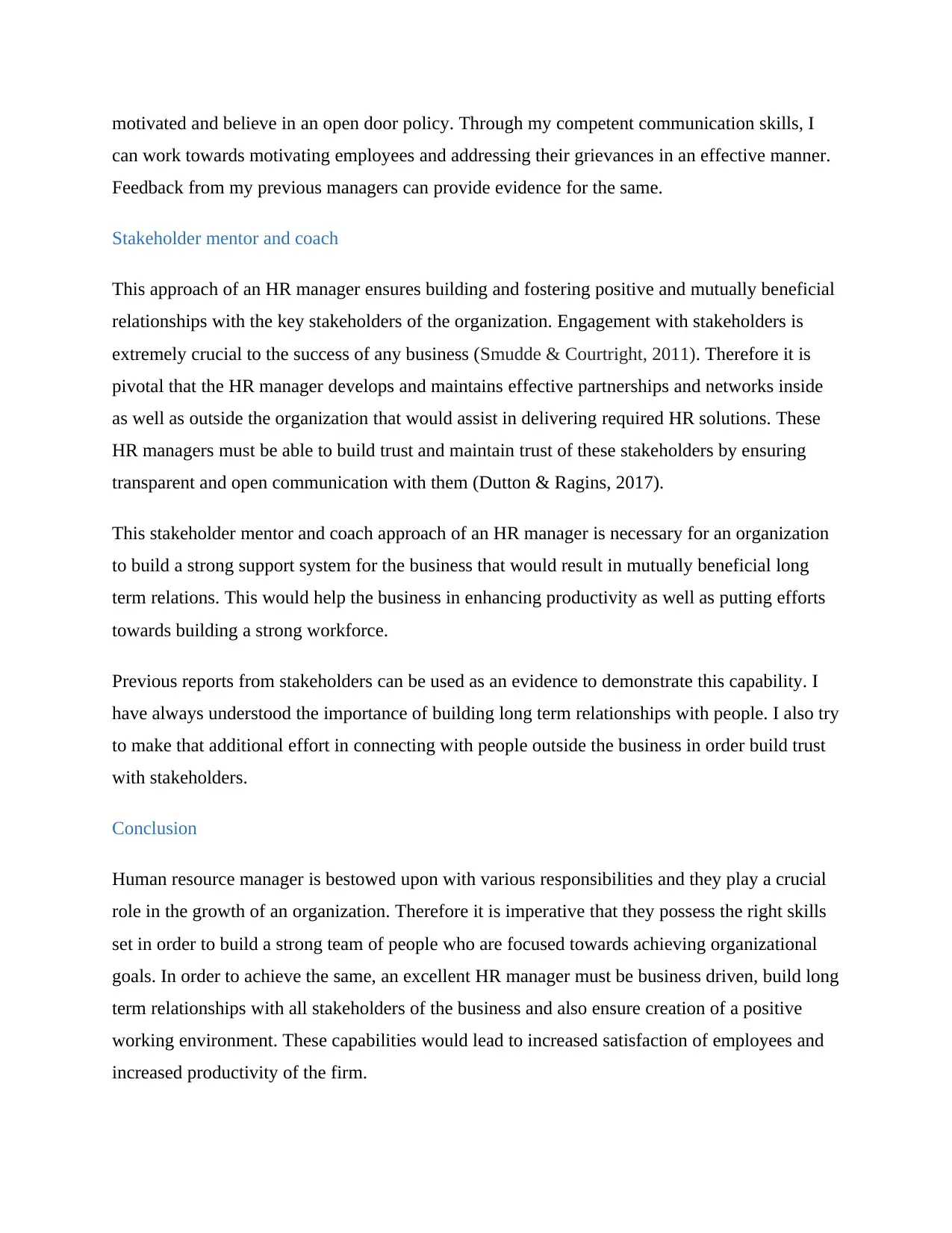
motivated and believe in an open door policy. Through my competent communication skills, I
can work towards motivating employees and addressing their grievances in an effective manner.
Feedback from my previous managers can provide evidence for the same.
Stakeholder mentor and coach
This approach of an HR manager ensures building and fostering positive and mutually beneficial
relationships with the key stakeholders of the organization. Engagement with stakeholders is
extremely crucial to the success of any business (Smudde & Courtright, 2011). Therefore it is
pivotal that the HR manager develops and maintains effective partnerships and networks inside
as well as outside the organization that would assist in delivering required HR solutions. These
HR managers must be able to build trust and maintain trust of these stakeholders by ensuring
transparent and open communication with them (Dutton & Ragins, 2017).
This stakeholder mentor and coach approach of an HR manager is necessary for an organization
to build a strong support system for the business that would result in mutually beneficial long
term relations. This would help the business in enhancing productivity as well as putting efforts
towards building a strong workforce.
Previous reports from stakeholders can be used as an evidence to demonstrate this capability. I
have always understood the importance of building long term relationships with people. I also try
to make that additional effort in connecting with people outside the business in order build trust
with stakeholders.
Conclusion
Human resource manager is bestowed upon with various responsibilities and they play a crucial
role in the growth of an organization. Therefore it is imperative that they possess the right skills
set in order to build a strong team of people who are focused towards achieving organizational
goals. In order to achieve the same, an excellent HR manager must be business driven, build long
term relationships with all stakeholders of the business and also ensure creation of a positive
working environment. These capabilities would lead to increased satisfaction of employees and
increased productivity of the firm.
can work towards motivating employees and addressing their grievances in an effective manner.
Feedback from my previous managers can provide evidence for the same.
Stakeholder mentor and coach
This approach of an HR manager ensures building and fostering positive and mutually beneficial
relationships with the key stakeholders of the organization. Engagement with stakeholders is
extremely crucial to the success of any business (Smudde & Courtright, 2011). Therefore it is
pivotal that the HR manager develops and maintains effective partnerships and networks inside
as well as outside the organization that would assist in delivering required HR solutions. These
HR managers must be able to build trust and maintain trust of these stakeholders by ensuring
transparent and open communication with them (Dutton & Ragins, 2017).
This stakeholder mentor and coach approach of an HR manager is necessary for an organization
to build a strong support system for the business that would result in mutually beneficial long
term relations. This would help the business in enhancing productivity as well as putting efforts
towards building a strong workforce.
Previous reports from stakeholders can be used as an evidence to demonstrate this capability. I
have always understood the importance of building long term relationships with people. I also try
to make that additional effort in connecting with people outside the business in order build trust
with stakeholders.
Conclusion
Human resource manager is bestowed upon with various responsibilities and they play a crucial
role in the growth of an organization. Therefore it is imperative that they possess the right skills
set in order to build a strong team of people who are focused towards achieving organizational
goals. In order to achieve the same, an excellent HR manager must be business driven, build long
term relationships with all stakeholders of the business and also ensure creation of a positive
working environment. These capabilities would lead to increased satisfaction of employees and
increased productivity of the firm.
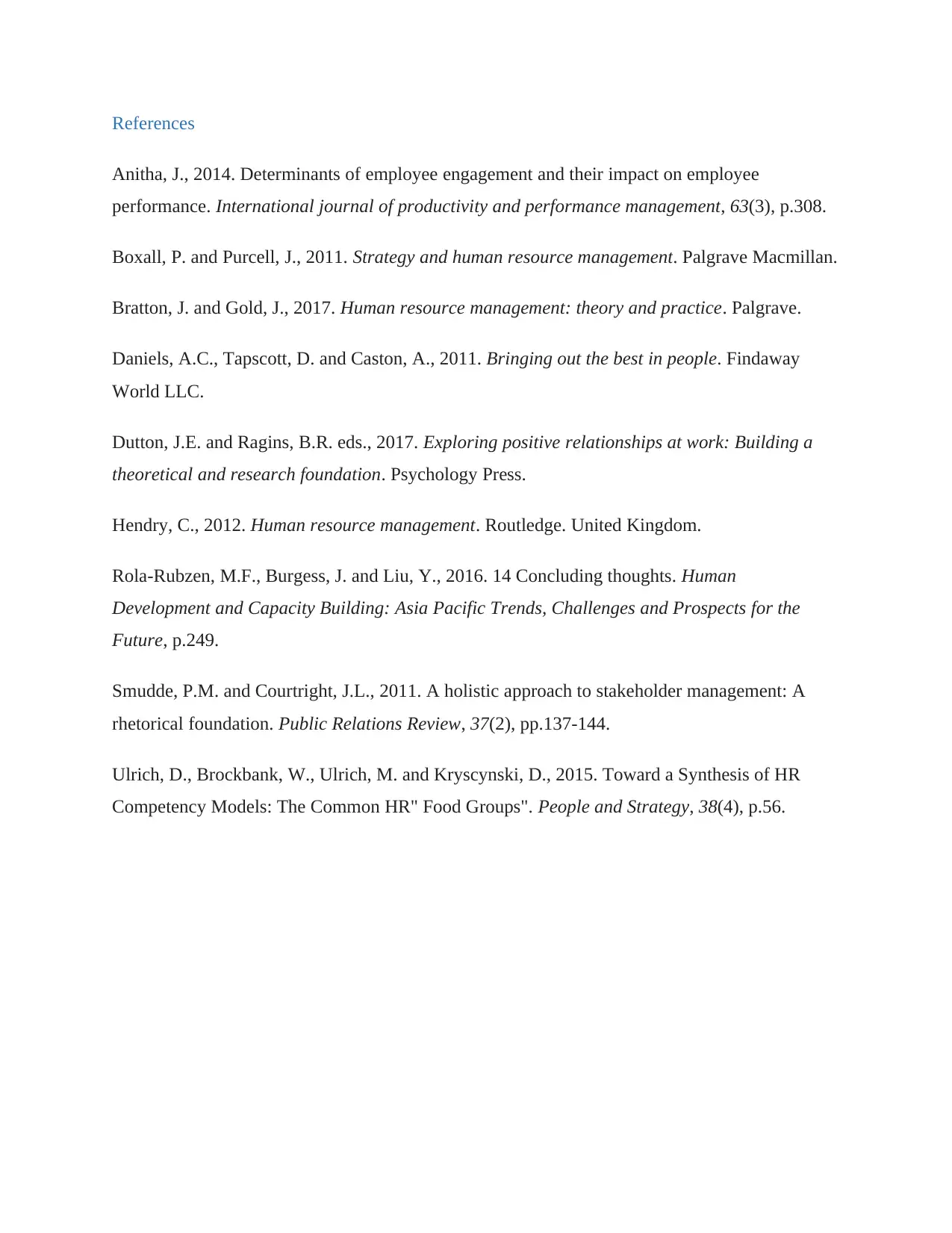
References
Anitha, J., 2014. Determinants of employee engagement and their impact on employee
performance. International journal of productivity and performance management, 63(3), p.308.
Boxall, P. and Purcell, J., 2011. Strategy and human resource management. Palgrave Macmillan.
Bratton, J. and Gold, J., 2017. Human resource management: theory and practice. Palgrave.
Daniels, A.C., Tapscott, D. and Caston, A., 2011. Bringing out the best in people. Findaway
World LLC.
Dutton, J.E. and Ragins, B.R. eds., 2017. Exploring positive relationships at work: Building a
theoretical and research foundation. Psychology Press.
Hendry, C., 2012. Human resource management. Routledge. United Kingdom.
Rola-Rubzen, M.F., Burgess, J. and Liu, Y., 2016. 14 Concluding thoughts. Human
Development and Capacity Building: Asia Pacific Trends, Challenges and Prospects for the
Future, p.249.
Smudde, P.M. and Courtright, J.L., 2011. A holistic approach to stakeholder management: A
rhetorical foundation. Public Relations Review, 37(2), pp.137-144.
Ulrich, D., Brockbank, W., Ulrich, M. and Kryscynski, D., 2015. Toward a Synthesis of HR
Competency Models: The Common HR" Food Groups". People and Strategy, 38(4), p.56.
Anitha, J., 2014. Determinants of employee engagement and their impact on employee
performance. International journal of productivity and performance management, 63(3), p.308.
Boxall, P. and Purcell, J., 2011. Strategy and human resource management. Palgrave Macmillan.
Bratton, J. and Gold, J., 2017. Human resource management: theory and practice. Palgrave.
Daniels, A.C., Tapscott, D. and Caston, A., 2011. Bringing out the best in people. Findaway
World LLC.
Dutton, J.E. and Ragins, B.R. eds., 2017. Exploring positive relationships at work: Building a
theoretical and research foundation. Psychology Press.
Hendry, C., 2012. Human resource management. Routledge. United Kingdom.
Rola-Rubzen, M.F., Burgess, J. and Liu, Y., 2016. 14 Concluding thoughts. Human
Development and Capacity Building: Asia Pacific Trends, Challenges and Prospects for the
Future, p.249.
Smudde, P.M. and Courtright, J.L., 2011. A holistic approach to stakeholder management: A
rhetorical foundation. Public Relations Review, 37(2), pp.137-144.
Ulrich, D., Brockbank, W., Ulrich, M. and Kryscynski, D., 2015. Toward a Synthesis of HR
Competency Models: The Common HR" Food Groups". People and Strategy, 38(4), p.56.
⊘ This is a preview!⊘
Do you want full access?
Subscribe today to unlock all pages.

Trusted by 1+ million students worldwide
1 out of 6
Related Documents
Your All-in-One AI-Powered Toolkit for Academic Success.
+13062052269
info@desklib.com
Available 24*7 on WhatsApp / Email
![[object Object]](/_next/static/media/star-bottom.7253800d.svg)
Unlock your academic potential
Copyright © 2020–2025 A2Z Services. All Rights Reserved. Developed and managed by ZUCOL.





